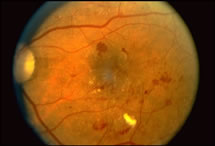Diabetes & The Eyes

A laser surgery procedure may be help in the treatment of diabetic retinopathy. The doctor will do a thorough evaluation of your diabetic retinopathy to determine the severity and judge how well the laser treatment may work. The decision to use a laser treatment is based on whether or not the laser treatment will help prevent further loss or vision rather than no treatment. Patients who have laser treatment may still continue to lose their vision but when a laser treatment is successful it can prevent further visual loss.
Focal laser treatment may be recommended for patients with non-proliferative diabetic retinopathy with significant macular edema, swelling of the macula. The laser is used to dry up the fluid that is causing the swelling to occur.
Pan-retinal laser photocoagulation (PRP) may be recommended for patients with proliferative diabetic retinopathy – abnormal new blood vessels called neovascularization. PRP destroys abnormal blood vessel growth.
Vitrectomy is a surgical procedure to remove the vitreous gel from the middle of the eye. This may be done to:
1. Reduce vision loss caused by bleeding in the vitreous (vitreous hemorrhage) when bleeding is severe of when the blood does not clear on its own after several months.
2. To treat severe proliferative retinopathy that causes scar tissue formation or when neovasularization continues despite repeated laser treatments.
3. To repair or prevent traction retinal detachment.
Vitrectomy is always done by an eye doctor who has special training in treating problems of the retina.
Intraocular steroid injection is a newly emerging treatment for diabetic macular edema. This therapy helps reduce the amount of fluid leaking into the retina, resulting in visual improvement. Due to the chronic nature of diabetic eye disease, this treatment may need to be repeated or combined with laser therapy to obtain maximal effect.
With early detection and modern treatment options the threat of vision loss from diabetic retinopathy is far less than ever before.

